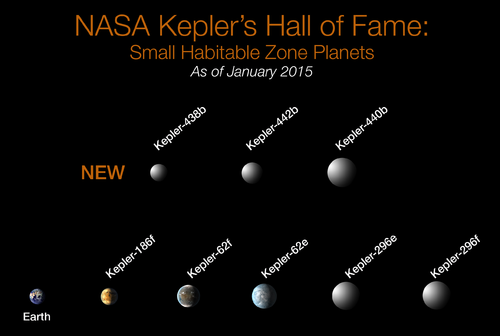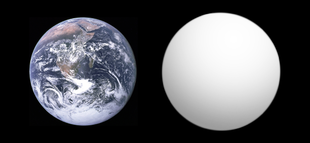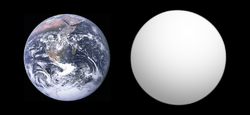Kepler-438b
| Exoplanet Kepler-438 b | |
|---|---|
| Ungefähre Größe von Kepler-438b (rechts) im Vergleich zur Erde | |
| Sternbild | Leier |
| Position Äquinoktium: J2000.0 | |
| Rektaszension | 18h 46m 35,0000s |
| Deklination | +41° 57′ 03,93″ |
| Orbitdaten | |
| Zentralstern | Kepler-438 |
| Große Halbachse | 0,166 AE |
| Exzentrizität | 0,03 +0,01−0,03 [1] |
| Umlaufdauer | 35,23319 ± 0,00029 d |
| Weitere Daten | |
| Radius | 1,120 |
| Entfernung | 145 pc [2][3] |
| Geschichte | |
| Datum der Entdeckung | 2015[4] |
| Katalogbezeichnungen | |
| KOI-3284.01, Kepler-438 b, KOI-3284 b, K03284.01, WISE J184634.98+415704.0 b, KIC 6497146 b, 2MASS J18463499+4157039 b | |
Kepler-438b (auch KOI-3284.01) ist ein bestätigter und nahezu erdgroßer Exoplanet, sehr wahrscheinlich ein Gesteinsplanet, der den Roten Zwerg[5] Kepler-438 im Sternbild Leier in dessen habitabler Zone umkreist.[2][3] Der Planet wurde durch das Weltraumteleskop Kepler der NASA mit Hilfe der Transitmethode entdeckt, wobei die geringfügige Verfinsterung des Sterns beim Vorüberziehen des Planeten gemessen wird. Die NASA gab die Bestätigung des Exoplaneten am 6. Januar 2015 bekannt.[2]
Bestätigter Exoplanet
Kepler-438b ist ein Exoplanet von nahezu der Größe der Erde mit 1,12 Erdradien. Der Planet umkreist den roten Zwergstern[5] Kepler-438, der wesentlich kleiner und kühler als die Sonne ist, in 35,2 Tagen.[2][3]
Bewohnbarkeit
Der Planet befindet sich in der habitablen Zone von Kepler-438, wo flüssiges Wasser auf seiner Oberfläche existieren könnte. Bei der Bekanntgabe seiner Entdeckung wurde Kepler-438b als einer der am meisten erdähnlichen Planeten bezeichnet, in Bezug auf seine Größe und Temperatur, die bis dahin gefunden worden sind.[2][3] Die Oberflächentemperatur wird zum Beispiel auf 276 Kelvin oder 3 °C geschätzt (berechnet als Gleichgewichtstemperatur bei einer angenommenen Bond-Albedo der Erde von 255 K. Die tatsächliche Temperatur dürfte sogar noch etwas höher liegen, abhängig von der nicht bekannten Atmosphäre, denn die mittlere Temperatur auf der Erdoberfläche beträgt auf Grund der Bond-Albedo 288 K oder 15 °C statt 255 K).

Siehe auch
Einzelnachweise
- ↑ Guillermo Torres, David M. Kipping, Francois Fressin, Douglas A. Caldwell, Joseph D. Twicken, Sarah Ballard, Natalie M. Batalha, Stephen T. Bryson, David R. Ciardi, Christopher E. Henze, Steve B. Howell, Howard T. Isaacson, Jon M. Jenkins, Philip S. Muirhead, Elisabeth R. Newton, Erik A. Petigura, Thomas Barclay, William J. Borucki, Justin R. Crepp, Mark E. Everett, Elliott P. Horch, Andrew W. Howard, Rea Kolbl, Geoffrey W. Marcy, Sean McCauliff, Elisa V. Quintana: Validation of Twelve Small Kepler Transiting Planets in the Habitable Zone. arxiv:1501.01101.
- ↑ a b c d e Jet Propulsion Laboratory: NASA's Kepler Marks 1,000th Exoplanet Discovery, Uncovers More Small Worlds in Habitable Zones. Abgerufen am 7. April 2015.
- ↑ a b c d The Guardian: Kepler 438b: Most Earth-like planet ever discovered could be home for alien life. Abgerufen am 7. April 2015.
- ↑ The Extrasolar Planet Encyclopaedia: Planet Kepler-438 b. Abgerufen am 7. April 2015.
- ↑ a b Paul Gilster: AAS: 8 New Planets in Habitable Zone. Abgerufen am 7. April 2015.
Weblinks
- Planetary Hability Laboratory, University of Puerto Rico: Habitable Exoplanets Catalog. Abgerufen am 7. April 2015. (englisch)
- National Astronautics and Space Administration: Kepler Mission. Abgerufen am 7. April 2015. (englisch)
- The Extrasolar Planet Encyclopaedia: Planet Kepler-438 b. Abgerufen am 7. April 2015. (englisch)
- National Astronautics and Space Administration: Kepler Discoveries. Abgerufen am 7. April 2015. (englisch)
- National Astronautics and Space Administration: NASA Exoplanet Archive. Abgerufen am 7. April 2015. (englisch)
Auf dieser Seite verwendete Medien
Autor/Urheber: Aldaron, a.k.a. Aldaron, Lizenz: CC BY-SA 3.0
Comparison of best-fit size of the exoplanet Kepler-186 f with the Solar System planet Earth, as reported in the Open Exoplanet Catalogue[1] as of 2014-04-20.
- ↑ Open Exoplanet Catalogue (2015-11-14). Retrieved on 2015-11-14.
NASA News
January 6, 2015
http://www.jpl.nasa.gov/news/news.php?release=2015-003
NASA's Kepler Marks 1,000th Exoplanet Discovery, Uncovers More Small Worlds in Habitable Zones
Of the more than 1,000 verified planets found by NASA's Kepler, eight are less than twice Earth-size and in their stars' habitable zone. All eight orbit stars cooler and smaller than our sun. The search continues for Earth-size habitable zone worlds around sun-like stars.
How many stars like our sun host planets like our Earth? NASA's Kepler Space Telescope continuously monitored more than 150,000 stars beyond our solar system, and to date has offered scientists an assortment of more than 4,000 candidate planets for further study -- the 1,000th of which was recently verified.
Using Kepler data, scientists reached this millenary milestone after validating that eight more candidates spotted by the planet-hunting telescope are, in fact, planets. The Kepler team also has added another 554 candidates to the roll of potential planets, six of which are near-Earth-size and orbit in the habitable zone of stars similar to our sun.
Three of the newly-validated planets are located in their distant suns' habitable zone, the range of distances from the host star where liquid water might exist on the surface of an orbiting planet. Of the three, two are likely made of rock, like Earth.
"Each result from the planet-hunting Kepler mission's treasure trove of data takes us another step closer to answering the question of whether we are alone in the universe," said John Grunsfeld, associate administrator of NASA's Science Mission Directorate at the agency's headquarters in Washington. "The Kepler team and its science community continue to produce impressive results with the data from this venerable explorer."
To determine whether a planet is made of rock, water or gas, scientists must know its size and mass. When its mass can't be directly determined, scientists can infer what the planet is made of based on its size.
Two of the newly validated planets, Kepler-438b and Kepler-442b, are less than 1.5 times the diameter of Earth. Kepler-438b, 475 light-years away, is 12 percent bigger than Earth and orbits its star once every 35.2 days. Kepler-442b, 1,100 light-years away, is 33 percent bigger than Earth and orbits its star once every 112 days.
Both Kepler-438b and Kepler-442b orbit stars smaller and cooler than our sun, making the habitable zone closer to their parent star, in the direction of the constellation Lyra. The research paper reporting this finding has been accepted for publication in The Astrophysical Journal.
"With each new discovery of these small, possibly rocky worlds, our confidence strengthens in the determination of the true frequency of planets like Earth," said co-author Doug Caldwell, SETI Institute Kepler scientist at NASA's Ames Research Center at Moffett Field, California. "The day is on the horizon when we'll know how common temperate, rocky planets like Earth are."
With the detection of 554 more planet candidates from Kepler observations conducted May 2009 to April 2013, the Kepler team has raised the candidate count to 4,175. Eight of these new candidates are between one to two times the size of Earth, and orbit in their sun's habitable zone. Of these eight, six orbit stars that are similar to our sun in size and temperature. All candidates require follow-up observations and analysis to verify they are actual planets.
"Kepler collected data for four years -- long enough that we can now tease out the Earth-size candidates in one Earth-year orbits," said Fergal Mullally, SETI Institute Kepler scientist at Ames who led the analysis of a new candidate catalog. "We're closer than we've ever been to finding Earth twins around other sun-like stars. These are the planets we're looking for."
These findings also have been submitted for publication in The Astrophysical Journal Supplement.
Work is underway to translate these recent discoveries into estimates of how often rocky planets appear in the habitable zones of stars like our sun, a key step toward NASA's goal of understanding our place in the universe.
Scientists also are working on the next catalog release of Kepler's four-year data set. The analysis will include the final month of data collected by the mission and also will be conducted using sophisticated software that is more sensitive to the tiny telltale signatures of small Earth-size planets than software used in the past.
Ames is responsible for Kepler's mission operations, ground system development and science data analysis. NASA's Jet Propulsion Laboratory in Pasadena, California, managed Kepler mission development. Ball Aerospace & Technologies Corp. in Boulder, Colorado, developed the Kepler flight system and supports mission operations with the Laboratory for Atmospheric and Space Physics at the University of Colorado in Boulder. The Space Telescope Science Institute in Baltimore archives, hosts and distributes Kepler science data. Kepler is NASA's 10th Discovery Mission and was funded by the agency's Science Mission Directorate in Washington.
For more information about the Kepler mission, visit:
http://www.nasa.gov/kepler

